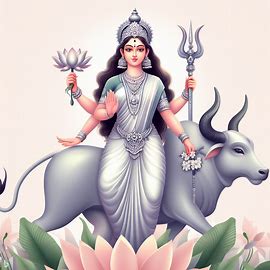
Maa Shailaputri: First day of Navaratri
Maa Shailaputri: Inaugural Form of Goddess Durga
In the grand tapestry of Hindu mythology and spirituality, Maa Shailaputri stands as the first manifestation of the divine goddess Durga, marking the commencement of the revered Navaratri festival. Often depicted riding a bull and holding a trident (trishul) in one hand and lotus flower in the other, Maa Shailaputri’s presence exudes strength, grace, and maternal warmth.
Origin and Mythological Significance:
The name “Shailaputri” translates to “Daughter of the Mountains,” where “Shaila” means mountain, and “Putri” signifies daughter. Legend has it that in her previous birth, Maa Shailaputri was born as Sati, the daughter of King Daksha. In her next life, she was reborn as Parvati, the daughter of the Himalayas. It is in this divine incarnation that she is worshipped as Maa Shailaputri.
Iconography:
Maa Shailaputri is often depicted with a crescent moon adorning her forehead, symbolizing purity and beauty. She is seen riding Nandi, the sacred bull, which is not only her mount but also an embodiment of strength and dharma. In her two hands, she carries a trident (representing the three fundamental qualities of nature – sattva, rajas, and tamas) and a lotus flower (symbolizing purity).
Spiritual Symbolism:
- Connection to Nature: Maa Shailaputri’s association with the mountains and her manifestation as the daughter of the Himalayas emphasize a deep connection to nature. Mountains, in many spiritual traditions, are considered abodes of gods and sources of strength.
- Feminine Power: As the first form of Goddess Durga, Shailaputri embodies the primal feminine energy. Her strength and fearlessness inspire devotees, particularly women, to recognize and embrace their inner power.
- Trident Symbolism: The trident she carries represents the three gunas (qualities) of the universe – creation, preservation, and destruction. It signifies the goddess’s control over these fundamental forces.
Worship and Celebrations:
Maa Shailaputri is worshipped on the first day of Navaratri, a nine-night festival dedicated to the various forms of Goddess Durga. Devotees observe fasts and offer prayers to seek her blessings for health, happiness, and prosperity. The rituals include reciting sacred hymns, singing devotional songs, and performing aarti in honor of the goddess.
Spiritual Teachings:
Maa Shailaputri’s divine qualities offer spiritual lessons to her devotees:
- Courage and Fearlessness: She symbolizes courage, fearlessness, and determination in the face of challenges. Her presence encourages individuals to overcome obstacles with resilience and strength.
- Purity and Serenity: The lotus in her hand signifies purity and serenity. Devotees seek her blessings to attain inner purity and lead a righteous life.
- Harmony with Nature: The association with the mountains and the bull emphasizes the importance of living in harmony with nature, recognizing the divine in all creation.
Conclusion:
Maa Shailaputri, embodiment of divine femininity and strength, marks the beginning of the Navaratri festival with her grace and blessings. As devotees immerse themselves in the festivities, they find inspiration in her teachings of courage, purity, and a harmonious connection with the cosmos. The worship of Maa Shailaputri sets the stage for the spiritual journey through the various forms of Goddess Durga, each representing unique aspects of the divine feminine energy.
Read about maa-brahmacharini: https://orangedosa.com/hinduism/maa-brahmacharinis-grace-on-the-second-day-of-navratri/